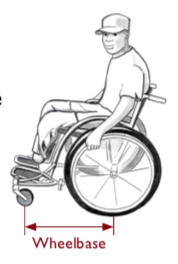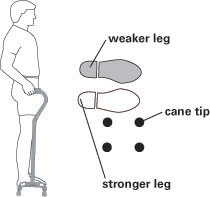Assistive Devices for Spinal Cord Injury: Difference between revisions
No edit summary |
(Added Technology Category) |
||
| (39 intermediate revisions by 5 users not shown) | |||
| Line 1: | Line 1: | ||
<div class=" | <div class="editorbox"> | ||
'''Original Editor '''- [[User:Kehinde Fatola|Kehinde Fatola]] | |||
''' | |||
'''Top Contributors''' - {{Special:Contributors/{{FULLPAGENAME}}}} | |||
</div> | |||
</div> | |||
== Introduction == | |||
[[File:4 Wheel Base.jpeg|thumb]] | |||
Individuals with [[Spinal Cord Injury|spinal cord injury]], just like patients with any other conditions, have a right to lead good quality and independent lives. However, due to the limitations presented by this condition, it is almost impossible to live a good life without some orthotic devices. These devices include mobility devices, hospital beds, [[Transfer Aids|transfer equipment]], positioning devices, respiratory devices, self-care equipment, environmental control devices, sports equipment, etc.<ref>StayWell K. Spinal Cord Injury (SCI): Adaptive Equipment. Available from: https://www.mhealth.org/Patient-Education/Articles/English/s/p/i/n/a/Spinal_Cord_Injury_SCI_Adaptive_Equipment_41175 (accessed 26/12/2020)</ref> However, there is limited research on compliance with prescribed adaptive equipment in patients with spinal cord injury. Knowledge regarding the causes of non-compliance will help in effective treatment planning and avoid unnecessary reimbursement costs covered by the state and users. A retrospective observational study identified non-compliance causes as medical-related factors (44.1%), client-related factors (20.6%), equipment-related factors (11.8%), and unspecific factors (17.8%) with improvement in the patient's health and high cost of the device the most common causes of non-compliance with adaptive equipment provisions<ref>Frasuńska J, Tederko P, Wojdasiewicz P, Mycielski J, Turczyn P, Tarnacka B. [https://www.minervamedica.it/en/journals/europa-medicophysica/article.php?cod=R33Y2020N02A0160&html=1&htmlID=Wm9OZWdqcCtrb1ZtSlBYeE9uMlhTNFVnc1JUVnc0TnJYSUFTeU42VkdURm1LVlJoRnEzSXFLYVBnenFBRGVwaQ%3D%3D#Top Compliance with prescriptions for wheelchairs, walking aids, orthotics, and pressure-relieving devices in patients with traumatic spinal cord injury.] Eur J Phys Rehabil Med 2020;56:160-8. | |||
</ref>. | |||
== Mobility Devices == | |||
[[File:Cane 1.jpg|thumb]] | |||
These are set of equipment that are used in moving patients with spinal cord injury, they include [[Wheelchair Design|wheelchairs]] (manual, sport, power, power-assisted), [[Walking Aids|walking frames]], [[crutches]], hand bike, [[canes|canes,]] and adapted shoes. It also includes adapted vehicles that can be used indoors, most times within the family. The essence of mobility devices is to give patients the maximum mobility possible rather than being confined to bed at a spot. <ref>Florio J, Arnet U, Gemperli A, Hinrichs T. [https://dx.doi.org/10.1080%2F10790268.2015.1114228 Need and use of assistive devices for personal mobility by individuals with spinal cord injury]. Journal of Spinal Cord Medicine. 2016; 39(4): 461–470.</ref> | |||
== Beds == | |||
This is very important, especially when considering skin care and protection. When choosing bed, height is a very important factor considering turning, positioning, transfers, and getting dressed. | |||
There are three types of beds based on the mode of control; full-electric, semi-electric, and manual beds. The levels of care to consider when choosing mattresses include pressure reduction, pressure relief and fluid. <ref>Craig Hospital. Beds for Spinal Cord Injuries. Available from: https://craighospital.org/resources/skin-care-bed-and-mattress (accessed 26/12/2020)</ref> | |||
</ | |||
== Transfer Equipment == | |||
These enable patients and caregivers move the patients about. It includes transfer boards, lifts, slings and benches. The purpose of transfer equipment is to drastically reduce the support a patient is needed from caregivers. | |||
== | |||
== Positioning Devices == | |||
Positioning devices help to keep body parts safe and as comfortable as possible while maintaining adequate functionality. They also help to keep the musculoskeletal body parts in good shape. They include [[Splint|splints]], braces, backrests and [[cushions]]. | |||
== Respiratory Equipment == | |||
These are used in patients with breathing problems and for [[suctioning]]. They include ventilators and Continuous Positive Airway Pressure (CPAP) machines. | |||
== Self-care Tools == | |||
They are essentially used for accomplishing self-care and personal routine tasks like menstrual, bowel and bladder care, eating, personal grooming and dressing. Self-care tools include shower bench or commode, dressing stick, reaching devices, adapted silverware, etc. | |||
== Environmental Control Devices == | |||
They are needed to control things in the immediate environment of the patients such as putting light on, answering the telephone, opening and closing doors and windows, etc. | |||
== Sports Equipment == | |||
They may include equipment used for various types of sports and recreational activities. It also includes physical activity and exercising implements. | |||
== | == Home Modifications == | ||
Home modifications are generally measures taken to ensure assistive technology fits into the structure of the home to ensure independence as much as possible. It also help to improve mobility, access and safety while preventing accidents too. Some common modifications are below; <ref>Living to the Max Occupational Therapy. Home Modifications. Available from: https://livingtothemax.com.au/our-services/home-modifications/ (Accessed 26/12/2020)</ref> | |||
* Changing existing floor pattern | |||
* Building additional structures | |||
* Converting existing rooms to suit purpose | |||
* Buying a new home | |||
* Enlargement of doorways and use of automatic doors | |||
* Installation of a ceiling hoist to assist transfers | |||
* Stair lifts | |||
* Dimensions for door handles, thresholds, hallways, floors, outlets and switches, telephones, furniture, bathroom toilet, sink, etc should be based on appropriate guidelines. | |||
It is also important to keep the tools well and in good working order to ensure safety and maintain independence. | |||
== Resources == | |||
* [https://www.sralab.org/lifecenter/resources/adapting-home-wheelchair-accessibility Adapting a home for wheelchair accessibility] | |||
* [https://one.nhtsa.gov/cars/rules/adaptive/brochure/brochure.html Adapting motor vehicles for persons with disability] | |||
== References == | == References == | ||
<references /> | <references /> | ||
[[Category:Spinal_Cord_Injuries]] [[Category:SCI_Content_Project]] | [[Category:Spinal_Cord_Injuries]] | ||
[[Category:SCI_Content_Project]] | |||
[[Category:Assistive Technology]] | |||
[[Category:Technology]] | |||
Latest revision as of 10:41, 12 March 2024
Original Editor - Kehinde Fatola
Top Contributors - Kehinde Fatola, Vidya Acharya, Admin, Naomi O'Reilly, Kim Jackson and Angeliki Chorti
Introduction[edit | edit source]
Individuals with spinal cord injury, just like patients with any other conditions, have a right to lead good quality and independent lives. However, due to the limitations presented by this condition, it is almost impossible to live a good life without some orthotic devices. These devices include mobility devices, hospital beds, transfer equipment, positioning devices, respiratory devices, self-care equipment, environmental control devices, sports equipment, etc.[1] However, there is limited research on compliance with prescribed adaptive equipment in patients with spinal cord injury. Knowledge regarding the causes of non-compliance will help in effective treatment planning and avoid unnecessary reimbursement costs covered by the state and users. A retrospective observational study identified non-compliance causes as medical-related factors (44.1%), client-related factors (20.6%), equipment-related factors (11.8%), and unspecific factors (17.8%) with improvement in the patient's health and high cost of the device the most common causes of non-compliance with adaptive equipment provisions[2].
Mobility Devices[edit | edit source]
These are set of equipment that are used in moving patients with spinal cord injury, they include wheelchairs (manual, sport, power, power-assisted), walking frames, crutches, hand bike, canes, and adapted shoes. It also includes adapted vehicles that can be used indoors, most times within the family. The essence of mobility devices is to give patients the maximum mobility possible rather than being confined to bed at a spot. [3]
Beds[edit | edit source]
This is very important, especially when considering skin care and protection. When choosing bed, height is a very important factor considering turning, positioning, transfers, and getting dressed.
There are three types of beds based on the mode of control; full-electric, semi-electric, and manual beds. The levels of care to consider when choosing mattresses include pressure reduction, pressure relief and fluid. [4]
Transfer Equipment[edit | edit source]
These enable patients and caregivers move the patients about. It includes transfer boards, lifts, slings and benches. The purpose of transfer equipment is to drastically reduce the support a patient is needed from caregivers.
Positioning Devices[edit | edit source]
Positioning devices help to keep body parts safe and as comfortable as possible while maintaining adequate functionality. They also help to keep the musculoskeletal body parts in good shape. They include splints, braces, backrests and cushions.
Respiratory Equipment[edit | edit source]
These are used in patients with breathing problems and for suctioning. They include ventilators and Continuous Positive Airway Pressure (CPAP) machines.
Self-care Tools[edit | edit source]
They are essentially used for accomplishing self-care and personal routine tasks like menstrual, bowel and bladder care, eating, personal grooming and dressing. Self-care tools include shower bench or commode, dressing stick, reaching devices, adapted silverware, etc.
Environmental Control Devices[edit | edit source]
They are needed to control things in the immediate environment of the patients such as putting light on, answering the telephone, opening and closing doors and windows, etc.
Sports Equipment[edit | edit source]
They may include equipment used for various types of sports and recreational activities. It also includes physical activity and exercising implements.
Home Modifications[edit | edit source]
Home modifications are generally measures taken to ensure assistive technology fits into the structure of the home to ensure independence as much as possible. It also help to improve mobility, access and safety while preventing accidents too. Some common modifications are below; [5]
- Changing existing floor pattern
- Building additional structures
- Converting existing rooms to suit purpose
- Buying a new home
- Enlargement of doorways and use of automatic doors
- Installation of a ceiling hoist to assist transfers
- Stair lifts
- Dimensions for door handles, thresholds, hallways, floors, outlets and switches, telephones, furniture, bathroom toilet, sink, etc should be based on appropriate guidelines.
It is also important to keep the tools well and in good working order to ensure safety and maintain independence.
Resources[edit | edit source]
References[edit | edit source]
- ↑ StayWell K. Spinal Cord Injury (SCI): Adaptive Equipment. Available from: https://www.mhealth.org/Patient-Education/Articles/English/s/p/i/n/a/Spinal_Cord_Injury_SCI_Adaptive_Equipment_41175 (accessed 26/12/2020)
- ↑ Frasuńska J, Tederko P, Wojdasiewicz P, Mycielski J, Turczyn P, Tarnacka B. Compliance with prescriptions for wheelchairs, walking aids, orthotics, and pressure-relieving devices in patients with traumatic spinal cord injury. Eur J Phys Rehabil Med 2020;56:160-8.
- ↑ Florio J, Arnet U, Gemperli A, Hinrichs T. Need and use of assistive devices for personal mobility by individuals with spinal cord injury. Journal of Spinal Cord Medicine. 2016; 39(4): 461–470.
- ↑ Craig Hospital. Beds for Spinal Cord Injuries. Available from: https://craighospital.org/resources/skin-care-bed-and-mattress (accessed 26/12/2020)
- ↑ Living to the Max Occupational Therapy. Home Modifications. Available from: https://livingtothemax.com.au/our-services/home-modifications/ (Accessed 26/12/2020)








